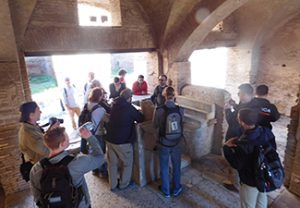
On International Women’s Day 2017, our group traveled across time and space to the ancient ruins of a once bustling port city for the Roman Empire: Ostia. Although a strike by the public transportation services delayed the trip shortly, a forty-five-minute taxi ride to the western coast allowed us to experience city, highway, and countryside driving while seeing the drastic difference between Rome and rural Italy. I must admit: I was extremely skeptical of walking around a bunch of ruins for an entire day. However, no other single experience on the trip proved to be as valuable to both my intellectual and personal development as Ostia. Inside the city of limits of Rome, buildings and other structures have continually been built on top of one another like a city of layers for over 2,000 years—one must be able to construct ancient structures using the imagination. At Ostia, excavations have revealed and preserved ancient buildings and structures that once fueled the major port city largely responsible for providing Rome with grain, meats, everyday commodities, and a great number of other exotic goods. For example, Benjamin Cox ’20 led the group around what we believe to be an ancient market square; each of the trading stalls had beautiful mosaics depicting the profession or type of goods available at each miniature store. Similarly, Dr. Hartnett led us into a 2,000-year-old bar, and we were immersed into a social space not very different to those we are able to enjoy today (See Picture). For lunch, we enjoyed a beautiful picnic inside a theatre that would have housed public entertainment for all social classes and served as a meeting place for the entire city (See Picture). On a different note, my presentation covering the Cult of Cybele provided the group with an example of a foreign religion entering traditional Roman society for a specific purpose: protecting the Republic from outside invaders. Brought from modern day Turkey via Ostia to Rome, a meteorite believed to be the ancient goddess Cybele provided Rome with protection from foreign adversaries and ensured fertility among Roman women. Although Roman citizens were forbidden to join the actual Cult of Cybele due to common practices of self-castration, Cybele was honored in traditional Roman practice: large annual feasts with singing, dancing, game, and competition. All-in-all, traveling to Ostia allowed us to explore and experience the quiet remains of a once vibrant and bustling port city while imagining the importance—or lack thereof—of individual structure’s relative weight in social, political, economic, and religious spheres of everyday life.